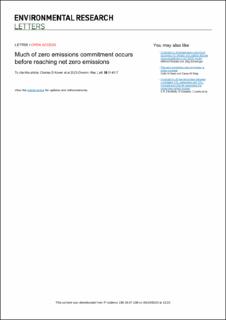| dc.contributor.author | Koven, Charles D | |
| dc.contributor.author | Sanderson, Benjamin M | |
| dc.contributor.author | Swann, Abigail L S | |
| dc.date.accessioned | 2024-02-22T09:47:51Z | |
| dc.date.available | 2024-02-22T09:47:51Z | |
| dc.date.created | 2023-03-30T14:57:13Z | |
| dc.date.issued | 2023 | |
| dc.identifier.citation | Environmental Research Letters. 2023, 18 (1), . | en_US |
| dc.identifier.issn | 1748-9326 | |
| dc.identifier.uri | https://hdl.handle.net/11250/3119224 | |
| dc.description.abstract | We explore the response of the Earth’s coupled climate and carbon system to an idealized sequential addition and removal of CO2 to the atmosphere, following a symmetric and continuous emissions pathway, in contrast to the discontinuous emissions pathways that have largely informed our understanding of the climate response to net zero and net negative emissions to date. We find, using both an Earth system model and an ensemble of simple climate model realizations, that warming during the emissions reduction and negative emissions phases is defined by a combination of a proportionality of warming to cumulative emissions characterized by the transient climate response to emissions (TCRE), and a deviation from that proportionality that is governed by the zero emissions commitment (ZEC). About half of the ZEC is realized before reaching zero emissions, and the ZEC thus also controls the timing between peak cumulative CO2 emissions and peak temperature, such that peak temperature may occur before peak cumulative emissions if ZEC is negative, underscoring the importance of ZEC in climate policies aimed to limit peak warming. Thus we argue that ZEC is better defined as the committed warming relative to the expected TCRE proportionality, rather than as the additional committed warming that will occur after reaching net zero CO2 emissions. Once established, the combined TCRE and ZEC relationship holds almost to complete removal of prior cumulative CO2 emissions. As cumulative CO2 emissions approach zero through negative CO2 emissions, CO2 concentrations drop below preindustrial values, while residual long-term climate change continues, governed by multicentennial dynamical processes. | en_US |
| dc.language.iso | eng | en_US |
| dc.publisher | IOP publishing | en_US |
| dc.rights | Navngivelse 4.0 Internasjonal | * |
| dc.rights.uri | http://creativecommons.org/licenses/by/4.0/deed.no | * |
| dc.title | Much of zero emissions commitment occurs before reaching net zero emissions | en_US |
| dc.title.alternative | Much of zero emissions commitment occurs before reaching net zero emissions | en_US |
| dc.type | Peer reviewed | en_US |
| dc.type | Journal article | en_US |
| dc.description.version | publishedVersion | en_US |
| dc.source.pagenumber | 0 | en_US |
| dc.source.volume | 18 | en_US |
| dc.source.journal | Environmental Research Letters | en_US |
| dc.source.issue | 1 | en_US |
| dc.identifier.doi | 10.1088/1748-9326/acab1a | |
| dc.identifier.cristin | 2138588 | |
| dc.relation.project | EC/H2020/101003536) | en_US |
| cristin.ispublished | true | |
| cristin.fulltext | original | |
| cristin.qualitycode | 2 | |

